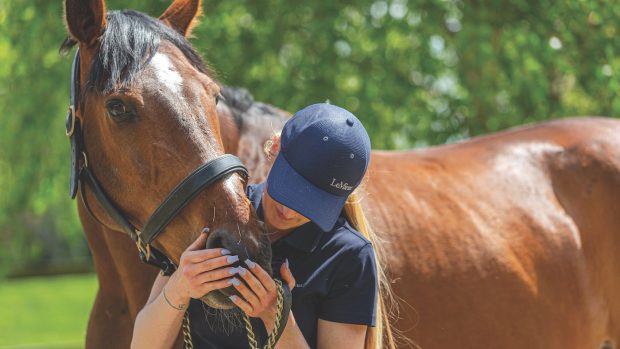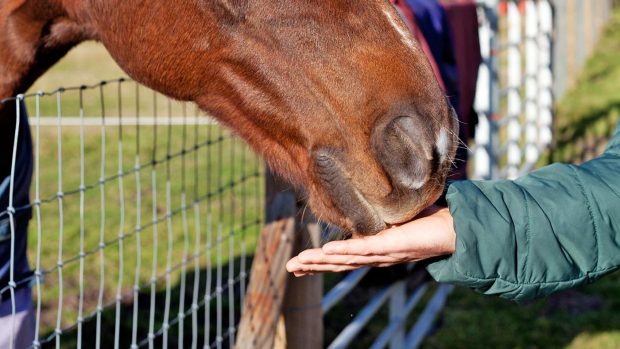A freelance groom who also runs a horse rescue has been so shocked by the scale of damage caused by the public feeding horses during lockdown that she is encouraging others to educate their local communities about the issue.
Seranna Barnett was first prompted to tackle the problem after two Shetland ponies she had placed in a foster home were made so ill by public feeding that one nearly had to be put down. The bill for their care came to £1,900.
“They’ve been in that home for the past four years, in the same routine, and we got a call from the people fostering them to say that one of them was ill, so we went down there immediately,” Seranna told H&H.
“The pony was lethargic and not eating, so we called the vet, suspecting colic. While the vet was there, the other pony also went downhill.”
While piebald Jenny rallied after three days, 12-year-old Sally required round-the-clock care and vets thought it was unlikely she would survive.
“There’s a footpath that runs along the top of the field and the vets suspected she had been fed something that was either poisonous or had caused her an allergic reaction,” Seranna said.
“She had what looked like chemical burns to her tongue and oesophagus and her whole digestive track was inflamed. She even had stomach lining come out, which is when the vets thought it might be over.
“As they were able to control her pain we let them continue treating her and within 10 days she pulled through. We will never know what she was fed.”
Seranna added that “everyone in the village was amazing”, putting up new fences to keep walkers well away from the ponies and raising money to help with the vets’ bill.
“While all this was happening, and we’d put it out on social media, I had other people contact me to say they had experienced the same thing. It just snowballed — up until that point I hadn’t realised the scale of what was happening.”
Seranna also works a freelance groom covering large areas of Warwickshire and Worcestershire and said she is witnessing yards near public rights of way suffering continued problems.
“We’re picking things out of people’s fields all the time,” she said. “I don’t even recognise some of the vegetables people have been putting in there.
“I can understand finding apples and carrots but there are marrows, sprouts, cauliflowers, rotten veg and rotten loaves of bread. Why would you even think you could go and feed that to horses?”
While a lot of equestrians are now rallying to spread the word, and organisations like the British Horse Society are producing posters to educate the public, some walkers are still behaving with a sense of entitlement.
“Owners put signs up and people ignore them, it’s a difficult situation,” Seranna said. “People don’t like thinking they’re being told what to do, so you have to try and educate them.
“One thing we have been doing is asking neighbours to be vigilant where there are footpaths and to give owners a call if they spot people feeding the animals.”
Funding to promote the countryside code has been minimal in recent decades and Seranna believes that being able to get the message through to children is the way forwards.
“I work for a couple of teachers and they have added information about the countryside code and feeding livestock into their lessons,” she said.
“I think the important thing is that even when lockdown lifts, we don’t let the baton drop.
“I have been running a rescue for 18 years and we are in the process of registering as a charity. We’ve run pony days in the past and when Covid restrictions allow, hopefully we can start them again and use the opportunity to educate people into what goes into owning and caring for a horse and what can cause them to have problems.
“I’d like to be able to leave my phone number at the field gate and say ‘you can’t feed them, but why don’t you arrange for the children to come and meet the ponies and learn about them instead?’”
Continues below…

Subscribe to Horse & Hound magazine today – and enjoy unlimited website access all year round

‘We’re in bits’: mare’s death likely caused by walkers feeding her
‘I just want to get the word out there: please don’t feed horses. However nice you think you’re being, this

‘Enough is enough’: riders join forces to stop the public from feeding horses
“I do get it; people haven’t got anything to do and they think it’s nice to feed the pony but
Seranna is also planning to leaflet local villages with information about feeding livestock and the heartbreak it has caused across the country.
“If everyone tried to do this in their local area, we might be able to get the message to go mainstream,” she said.
“As things are at the moment, it’s hard not to get paranoid about it. It can be difficult enough to keep horses in one piece at the best of times, without added worries from outsiders. I can’t believe how large the problem has become.”
Horse & Hound magazine, out every Thursday, is packed with all the latest news and reports, as well as interviews, specials, nostalgia, vet and training advice. Find how you can enjoy the magazine delivered to your door every week, plus options to upgrade to access our H&H Plus online service which brings you breaking news as it happens as well as other benefits.





